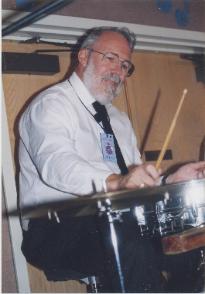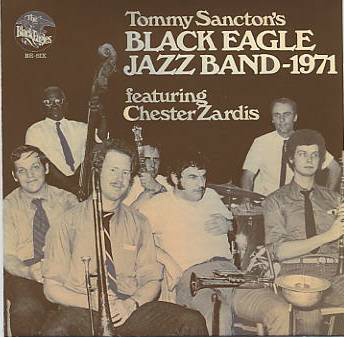Rollº; New Rag; Dippermouth Blues; Snake Rag; Dallas Bluesº; Ice Creamº; Red Man
Blues; Lord, Lord, Lordº; God Bless the Child†; St. Louis Blues†; Bogalusa Strut.
Recorded at Intermediate Studios, Boston, on May 8 and 9*, 1971.
Personnel: Tommy Sancton, clarinet; Tony Pringle, cornet, vocalº; Jim Klippert,
trombone; Peter Bullis, banjo; Eli Newberger, piano; “Pam” Pameijer, drums; Chester
Zardis, bass; Bonnie Bagley, vocal†.
This is the tenth in a series of fourteen limited edition CD’s, reissuing material by the
band that previously appeared on LP’s—mainly on their own label but also on a few
other small labels, such as Philo, Philips, and Dirty Shame—and on cassette tapes.
Some of these cassettes were issued simultaneously with the LP’s but also contained
additional tracks. Other cassettes with different material were issued in that format
only. When the company that produced the cassettes went out of business, the digital
masters were returned to the band. These form the basis of most of the material on this
CD set.
This CD reissues the recordings made by the first edition of the band, which was started
by Tommy Sancton and Tony Pringle and called the Black Eagle Jazz Band. (After
several personnel changes, the “New” was added to distinguish the later group.) The
liner notes from the original LP written by Sancton are included here and tell the story of
how it all came together. All of the tracks from that LP have been retained and three
previously unissued tracks—God Bless the Child, St. Louis Blues, and Bogalusa Strut—
are added.
As a glance at the personnel will show, four of the seven of the early group were in at
the creation of the New Black Eagles Jazz Band, and with the exception of Newberger,
are still with the band today. When Sancton left for England, several clarinet players
came and went until Billy Novick became the regular clarinetist. Also about that time,
Klippert headed to California, and Stan Vincent came in on trombone. The band back
then had no regular bass player, so they opted to send for Chester Zardis from New
Orleans, with whom they had played when down there at the New Orleans Jazz &
Heritage Festival, for the recording date. When the New Black Eagles formed,
Newberger switched from piano to tuba, and Bob Pilsbury came in on piano.
Interestingly enough, after Newberger’s departure the band reverted to using the string
bass.
Even at this early stage in the band’s development, many of the features are already,
even if nascent, in place. The driving ensemble passages are to be found in almost
every tune on the disc. Solos are invariably backed by more than just the rhythm
section. Stop time is invariably clean and precise—witness Perdido Street Blues and
Dippermouth Blues, to cite just a couple of instances. The same can be said of the
harmonic runs, most often between cornet and clarinet, Snake Rag offering the best
example here.
One senses the whole band is really focused and on top of the number. This is
particularly true of tunes that are taken at tempos that invite train wrecks, such as Snake
Rag and Bogalusa Strut—but such disasters never occur.
While the tune list on this CD contains many standards, they are not given tired
renditions, as can be inferred from what has been said about the band’s approach to
them. However, not all the selections are standards. New Rag is one such, a beautiful
rag by Scott Joplin, the king of ragtime, that is given a full band treatment here, with
many difficult harmonic figures traced immaculately by the cornet and clarinet. Red
Man Blues is another piece not often heard, with its memorable staggered clarinet
pattern over the stop time of the rest.
Before closing, I must draw attention to Sancton’s clarinet playing. It does tend to
dominate here, perhaps in part because of the mike placement, but it is well worth
hearing, replete as it is with touches gained from his mentor for so long, George Lewis.
It would be difficult to miss the Lewis component of the counter melodies Sancton
plays, even to the heavy borrowing from Burgundy Street Blues that he engages in
during Red Man Blues. His warm, woody tone, and his facility in all registers, these too
suggest Lewis. When Sancton left the band, undoubtedly there were some heavy hearts.
Like all of the CD’s in this set, this one is very desirable, especially if one wishes to be
acquainted with an early version of the band. According to the band, ordering
information is as follows:
The 14 CD’s are a set only in that they represent 14 reissues of LPs and Cassettes from
the earlier days of the Black Eagles. We have not priced them as a set and have typically
sold them as individual items. You can find them by going to -
http://www.blackeagles.com/x.fullsite/cgi-bin/online-orderform.asp
To the right of the window you will see four lists - aisle 1, 2, 3 and 4. Click on aisle 2 and
you will have an order form listing all 14 of the CDs.
*Sancton’s liner notes have May 9 and 10, 1971, as the recording dates; the back tray
insert has the dates given above.
|
|



